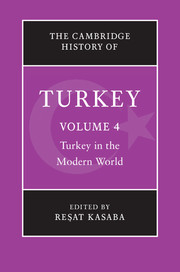Book contents
- Frontmatter
- 1 Introduction
- PART I OTTOMAN BACKGROUND AND TRANSITION
- PART II REPUBLIC OF TURKEY
- 7 Migration and Turkey: the dynamics of state, society and politics
- 8 The migration story of Turks in Germany: from the beginning to the end
- 9 Politics and political parties in Republican Turkey
- 10 Economic change in twentieth-century Turkey: is the glass more than half full?
- 11 Ideology, context and interest: the Turkish military
- 12 Kurds and the Turkish State
- 13 Islam and politics in contemporary Turkey
- 14 Sufism and Islamic groups in contemporary Turkey
- 15 Contestation and collaboration: women’s struggles for empowerment in Turkey
- 16 Art and architecture in modern Turkey: the Republican period
- 17 The novel in Turkish: narrative tradition to Nobel prize
- 18 A brief history of modern Istanbul
- Select bibliography
- Index
- References
16 - Art and architecture in modern Turkey: the Republican period
from PART II - REPUBLIC OF TURKEY
Published online by Cambridge University Press: 28 November 2009
- Frontmatter
- 1 Introduction
- PART I OTTOMAN BACKGROUND AND TRANSITION
- PART II REPUBLIC OF TURKEY
- 7 Migration and Turkey: the dynamics of state, society and politics
- 8 The migration story of Turks in Germany: from the beginning to the end
- 9 Politics and political parties in Republican Turkey
- 10 Economic change in twentieth-century Turkey: is the glass more than half full?
- 11 Ideology, context and interest: the Turkish military
- 12 Kurds and the Turkish State
- 13 Islam and politics in contemporary Turkey
- 14 Sufism and Islamic groups in contemporary Turkey
- 15 Contestation and collaboration: women’s struggles for empowerment in Turkey
- 16 Art and architecture in modern Turkey: the Republican period
- 17 The novel in Turkish: narrative tradition to Nobel prize
- 18 A brief history of modern Istanbul
- Select bibliography
- Index
- References
Summary
For many people, foreigners and Turks alike, ‘modern Turkish art and architecture’ is nothing more than a lamentable story of progressive decline from the past glory of their classical Ottoman counterparts. It is still the mosques, costumes and calligraphy of the Ottoman Empire that often represents Turkey in major international exhibitions and cultural events, and continues to define what most people consider to be the country’s ‘national heritage’. More recently, however, partly triggered by the country’s rekindled prospects of joining the EU, there is a growing recognition that the country’s claims to ‘modernity’ will ring hollow without a parallel display of modern cultural production. Events like the 2004 opening of the country’s first modern art museum, the Istanbul Modern, or the hosting of the 2006 International DoCoMoMo (Documentation and Conservation of the Modern Movement in Architecture) Conference in Turkey, are, without doubt, significant ‘firsts’. Yet any broader public awareness and appreciation of Republican modernist heritage is still very minimal at best. Most of the time, the works themselves are threatened with neglect and oblivion, if not outright destruction.
The aesthetic merits of modern Turkish art and architecture are matters of ongoing academic debate. What is beyond dispute, however, is that Turkish modernism deserves attention for reasons beyond the more traditional and autonomous disciplinary concerns of art and architecture (such as stylistic, aesthetic, technical and preservationist concerns). Although these are by no means unimportant, it is far more provocative to look at Turkish modernism as a compelling example of how paintings, artwork, buildings, projects and urban spaces are as much the active means by which modern national identities are produced and reproduced as they are formal/stylistic reflections of these historical experiences.
- Type
- Chapter
- Information
- The Cambridge History of Turkey , pp. 419 - 471Publisher: Cambridge University PressPrint publication year: 2008
References
- 2
- Cited by

